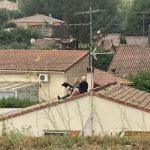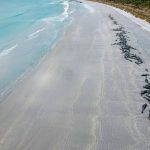Treading carefully but quickly around her family home, Simge Ozdel is packing up her life.
She moves from room to room picking up urgent medicine for her diabetic father, as well as anything she can recover from her flat in Adana that was torn apart by the earthquake.
Simge was in her childhood bedroom when the tremors started.
“I realised the building was falling on top of me. Then I fled to the hallway and shut the door and when I did, the whole wall came down,” she tells us.
The family has been told by inspectors the building will be reinforced and at some point, they can return.
But for now, the three of them will live in Istanbul.
Anger rising
With every day, public anger is intensifying. Turkish President Recep Tayyip Erdogan has struggled to defend his response to the earthquake.
Videos from a few years ago have emerged showing him praising one of the housing projects in Maras that crumbled, killing thousands of people.
On one, taken during a campaign stop ahead of Turkey’s March 2019 elections, Mr Erdogan said: “We solved the problem of 144,156 citizens of Maras with zoning amnesty.”
Critics say the amnesties, which forgave faults in millions of buildings and the lack of enforced safety measures likely contributed to the soaring death toll.
‘We are always going backwards’
In Iskenderun, we meet Mustafa Onal who is loading up his motorbike with supplies. It is the first time he will step inside his flat since the earthquake.
He is scared of aftershocks and invites us to see his home. There are deep cracks on the inside and outside of the building.
Click to subscribe to the Sky News Daily wherever you get your podcasts
Mustafa sees greed.
“In Turkey, there is no progress,” he says.
“We’re always going backwards. Architects, contractors, they’re just looking at how they can steal, how they can gain.”
Read more:
Before and after images highlight earthquake devastation
Syrian refugees fleeing back from Turkey after earthquake
President of Adana Chamber of Architects, Sedat Gul, meets us in the city, next to a building completely ripped apart by the earthquake. He is angry.
“There has been a void in the inspection process,” he says.
“Local administrations like municipalities and contractors, void of any ethics, have cut corners and tried to make money.
“They’ve used loopholes in the law for their personal gain.”
There were warnings about the infrastructure of the buildings not being up to standard.
Last year, the Turkish environment minister said 6.8 million homes in the country were considered risky and 1.5 million needed to be torn down urgently.
Be the first to get Breaking News
Install the Sky News app for free
What is striking across the region are these buildings standing side-by-side that face completely different fates, one obliterated and the other completely intact.
There are lots of buildings like this with huge cracks in them and now they’ll have to be inspected. If there is structural damage they’ll have to be torn down.
A hellish landscape
In the port city of Iskenderun, Fatma is desperate to get back into her home.
She says her daughter and grandson are still in the burnt-out building.
“They’re gone, they’re gone,” she cries. “I cannot breathe.”
She is consoled by a relative who cradles her. It is a hellish landscape.
In those rare, still moments, this feels like a museum of mourning.
No one chose to visit of course, and yet so many will struggle to leave.






















